Bass
now browsing by category
Posted by: Warren Prior | on August 27, 2013
Kamberg Nymph
Posted in Bass, Fly Tying, Fresh Water Fly, Trout | No Comments »
Posted by: Warren Prior | on August 5, 2013
Papa Roach
Posted in Bass, Fly Tying, Fresh Water Fly, Trout | No Comments »
Posted by: admin | on October 22, 2012
Backwater Bass Bent Back
Backwater Bass Bent Back |
|
|
|
|
Materials |
|
| Hook | Stinger 2/0 or bigger |
| Thread | Red or Olive 3/0 |
| Flash | Of Choice |
| Body | Chartreuse Cactus Chenille |
| Tail | Olive Buck tail and Peacock Hurl |
| Head | Red and Olive Hackle |
Tying Instructions |
|
| 1) Prepare the hook by putting in a slight bend about 1/3 from eye. Bend just enough to get the hook to swim point up.
2) Starting right from within the bend of the hook wrap the cactus chenille forward to the bend and tie off. 3) Tie in a clump of buck tail on top of the shank at the bend. (hook point up). This must extend beyond the hook and also acts as a weed guard by protecting the hook point. 4) Tie in some flash above the buck tail. This can be slightly longer than the buck tail.. 5) Top of with 5 or 6 peacock hurls. 6) Just ahead of the Buck tail tie in a red hackle buy the base, curved side down and wrap forward in tight turns forming a neat collar. 7) Just in front of the red repeat with an Olive hackle. 8) Form a neat thread head, whip finish and cement. |
|
Variation |
|
|
|
|
Posted in Bass, Fly Tying, Fresh Water Fly | No Comments »
Posted by: Warren Prior | on October 14, 2012
MSK (Mikes Scalie Killer)
MSK (Mikes Scalie Killer) |
|
A yellowfish variation of the woolly bugger. |
|
|
|
|
Materials |
|
| Hook | Daiichi DHSS #3 or smaller |
| Thread | Chartreuse 3/0 or finer |
| Head | Tungsten Bead pref. faceted |
| Tail | Filoplume from Schlappen Hackle + Flash |
| Body | Sparkle dubbing |
| Rib | Fine Copper Wire (optional) |
| Wing Case | Flashabou |
| Legs | Teased out dubbing |
Tying Instructions |
|
| 1) Thread bead onto hook and dress the hook shank with thread to above the barb.
2) Cut a bunch of filoplume from the base of a hen hackle. Tie this in above the barb using the pinch method. 3) Tie in one strand of flash either side of tail as well as the copper wire for rib if desired. 4) Form a dubbing noodle at the tail tie in point and wrap forward 2/3 along hook shank forming the body. 5) At this point tie in the flash for the wing case on top of the hook. 6) Carry on dubbing in front of the flash right up to the bead. 7) Pull the flash over the top forming the wing case and tie off behind the bead. 8) Keep wrapping the chartreuse thread behind the bead forming a neat chartreuse band behind the bead. 9)Whip finish and apply a small amount of head cement. 10) This fly is very effective for Natal Scalies especially when the water is not clear and can be tied in browns and greens. |
|
Posted in Bass, Fly Tying, Fresh Water Fly, Trout, Yellowfish | No Comments »
Posted by: Warren Prior | on October 14, 2012
Marco’s Bass Muddler
Marco’s Bass Muddler |
|
Marco’s variation on the bass muddler. |
|
|
|
|
Materials |
|
| Hook | Size #4 long Shank |
| Thread | 3/0 Mono Colour to match |
| Overbody | Flourescent Fritz or Chenille (Crystal) |
| Wing | Deer Hair topped with Marabou and Peacock Herl |
| Collar | Spun Deer Hair |
| Head | Spun deer hair clipped to shape |
| Tail | Marabou or Bucktail (red orange chartreuse) |
Tying Instructions |
|
| 1. Start thread above barb of hook and tie in flat section of foam.
2. Tie in the tail (1/3 length of hook shank) and fritz. Wind the thread forward to about 1/2 the shank length from the eye. 3. Wind the fritz forward over the foam and tie off at the same point. 4. Stack a clump of deer hair in a stacker and tie in directly in front of the Fritz on top of the hook. The tips should extend to the bend in the hook. 5. Tie in a small bunch of marabou directly over the deer hair (colour of choice) and 4-5 Peacock Herls directly on top of that. 6. Stack a thick clump of deer hair in the stacker and spin a collar around the hook shank. 7. Repeat the above step (stacking no longer required) over and over until the front third of the shank is covered. make sure to pack the hair tightly back after each application. 8. Tie off the thread behind the hook eye and apply a drop of head cement, then shape the head with scissors or a sharp razor blade. The larger the head and collar the better the pattern will float. Note: The collar particularly the bottom provides most of the buoyancy to the fly. Clipping the bottom close to the hook shank results in a loss of buoyancy thus allowing the fly to fish sub surface. |
|
Fishing Instructions |
|
| Due to the wind resistance of the pattern at least a 5/6 weight rod is required. Cast in the direction of the bank (as close as possible) or structure, allow to settle for a few seconds then give a a few rapid short strips interspersed with pauses of a few seconds. Continue to strip until over the drop off and the repeat the sequence gradually covering all the water in front of you. The idea is to create sufficient disturbance to test the agression of the bass. By the way many a wary trout has been caught in the shallows in the early morning and late evenings on windy/stormy days. | |
Posted in Bass, Fly Tying, Fresh Water Fly | No Comments »
Posted by: Warren Prior | on October 14, 2012
Natal Minnow
Natal Minnow |
|
This fly was originally tied by Robin Fick. Recipe courtesy of Eric Pattenden. |
|
|
|
|
Materials |
|
| Hook | #4 to #10 Long Shank |
| Thread | Red |
| Head | Black Thread |
| Tail | Black Hackle |
| Body | Red Thread |
| Wings | 18 Selected Mallard Flank Feathers |
| Hackle | Red Hen |
Tying Instructions |
|
| 1) Dress the hook with thread to above hook barb.2) Tie in the tail at this point. The tail length should be 1 to 1.5 times hook shank length.
3) From the tail tie in point dress the hook with Red thread to where the head would start and tie off. (Eric says that chenille should not be used as it is too bulky and the feathers would not lie flat.) 4) Sort the feathers into 3 groups of 6 equally sized feathers. the 6 tail end feathers should be the smallest and the head end feathers the largest. These must be the full length of the body and will end just past the hook bend. Measure the feathers against the hook and strip the fibres below the tie in point. 5) Tie in the first feather about 1/4 up the shank as shown in the picture above. The tip of the feather should be just past the hook bend. The feather must be parallel to the hook bend. Tie in two more matched feathers. If the feathers have a bias it should be downward. Then repeat on the back of the fly. Note: The stripped portion of the quill should extend to the next tie in point. 6) In loose turns take the thread forward to the next tie in point trapping the stripped stems to the sides of the hook. 7) Now tie in the next set of feathers as described above with the lining up with the first set. Then in loose turns bring the thread to the final tie in point behind the head. 8) Keeping the best feathers for the outside of the fly tie in the last set as before. This set forms the full body of the fly and should extend to the tips of the first set of feathers. 9) Next tie in a red hackle just in front of the last tie in point. After 3 or 4 turns tie off and form a neat head with the black thread. The red hackle should be forced back over the body feathers as the head is tied in forming a swept back collar around the body feathers. 10) Varnish the head with you favourite head cement. 11) The fly is traditionally tied with mallard flank feathers (partridge used in the demo tying sequence) Experimenting with different types of feathers can produce interesting results. |
|
Posted in Bass, Fly Tying, Fresh Water Fly, Trout | No Comments »
Posted by: Warren Prior | on October 14, 2012
Bass Muddler
Bass Muddler |
|
Due to the wind resistance of the pattern at least a 5/6 weight rod is required. Cast in the direction of the bank (as close as possible) or structure, allow to settle for a few seconds then give a a few rapid short strips interspersed with pauses of a few seconds. Continue to strip until over the drop off and the repeat the sequence gradually covering all the water in front of you. The idea is to create sufficient disturbance to test the agression of the bass. By the way many a wary trout has been caught in the shallows in the early morning and late evenings on windy/stormy days. |
|
|
|
|
Materials |
|
| Hook | SS Size #4 long Shank |
| Thread | 3/0 Mono Colour to match |
| Underbody | White or Black Foam (optional) |
| Overbody | Fluorescent Fritz or Chenille (Crystal) |
| Wing | Deer Hair topped with Marabou and Peacock Herl |
| Collar | Spun Deer Hair |
| Head | Spun deer hair clipped to shape |
| Tail | Marabou or Bucktail (red orange chartreuse) |
Tying Instructions |
|
| 1. Start thread above barb of hook and tie in flat section of foam.2. Tie in the tail (1/3 length of hook shank) and fritz. Wind the thread forward to about 1/3 the shank length from the eye.3. Wrap the foam in overlapping turns toward the hook eye and tie it off when the end of the thread is reached.
4. Wind the fritz forward over the foam and tie off at the same point. 5. Stack a clump of deer hair in a stacker and tie in directly in front of the Fritz on top of the hook. The tips should extend to the bend in the hook. 6. Tie in a small bunch of marabou directly over the deer hair (colour of choice) and 4-5 Peacock Herls directly on top of that. 7. Stack a thick clump of deer hair in the stacker and spin a collar around the hook shank. 8. Repeat the above step (stacking no longer required) over and over until the front third of the shank is covered. make sure to pack the hair tightly back after each application. 9. Tie off the thread behind the hook eye and apply a drop of head cement, then shape the head with scissors or a sharp rasor blade. The larger the head and collar the better the pattern will float. Note: The collar particularly the bottom provides most of the buoyancy to the fly. Clipping the bottom close to the hook shank results in a loss of buoyancy thus allowing the fly to fish sub surface. The foam in this type of application should also be omitted. |
|
Posted in Bass, Fly Tying, Fresh Water Fly | No Comments »

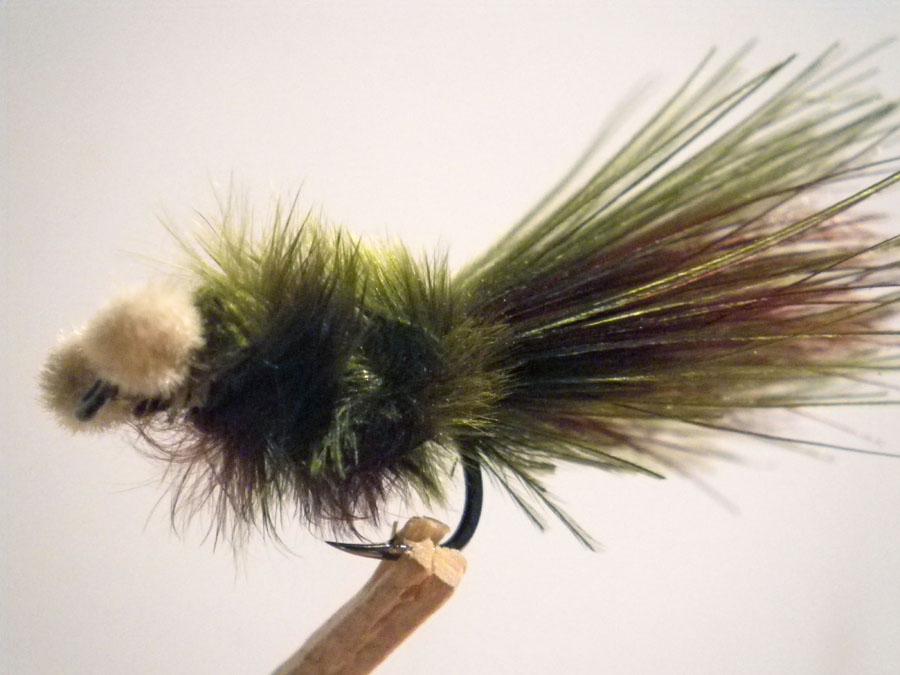
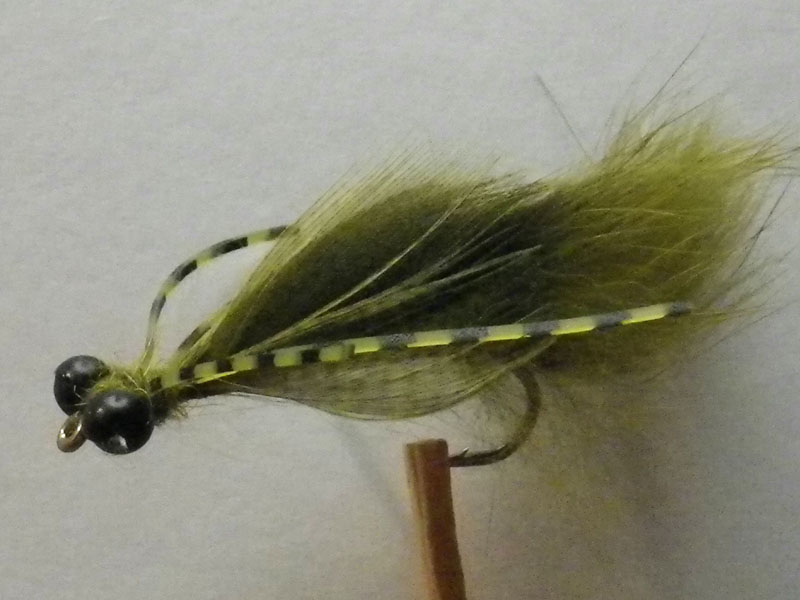
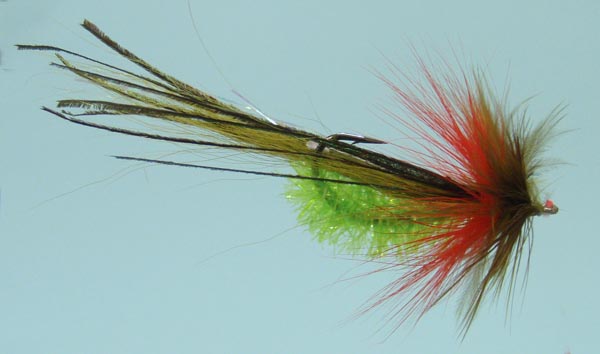
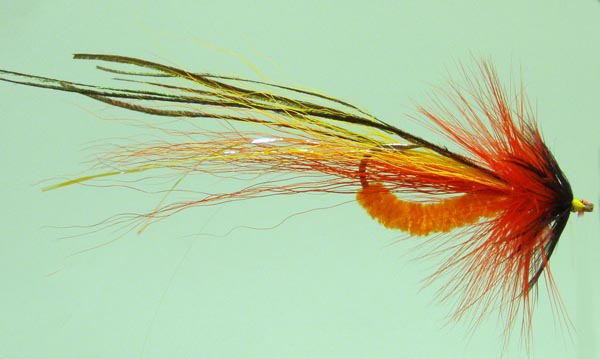
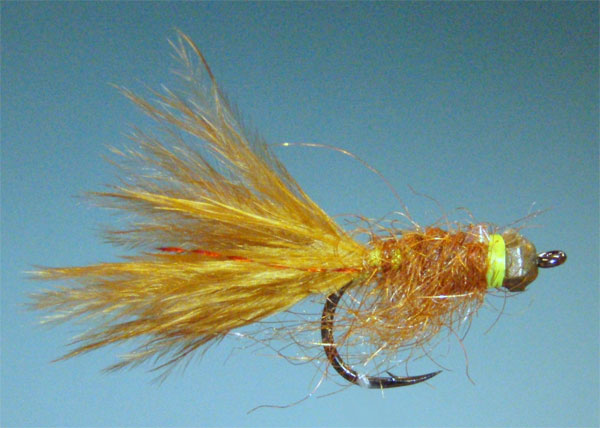
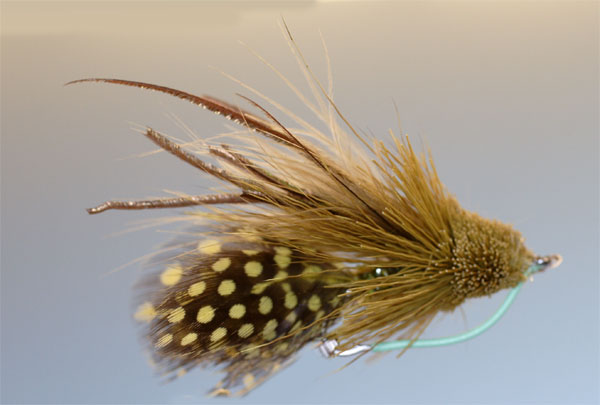
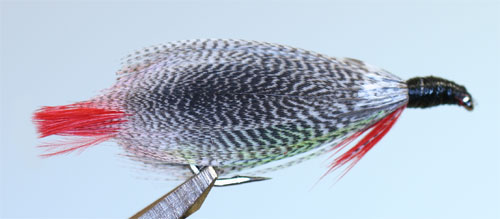
 D5 Creation
D5 Creation